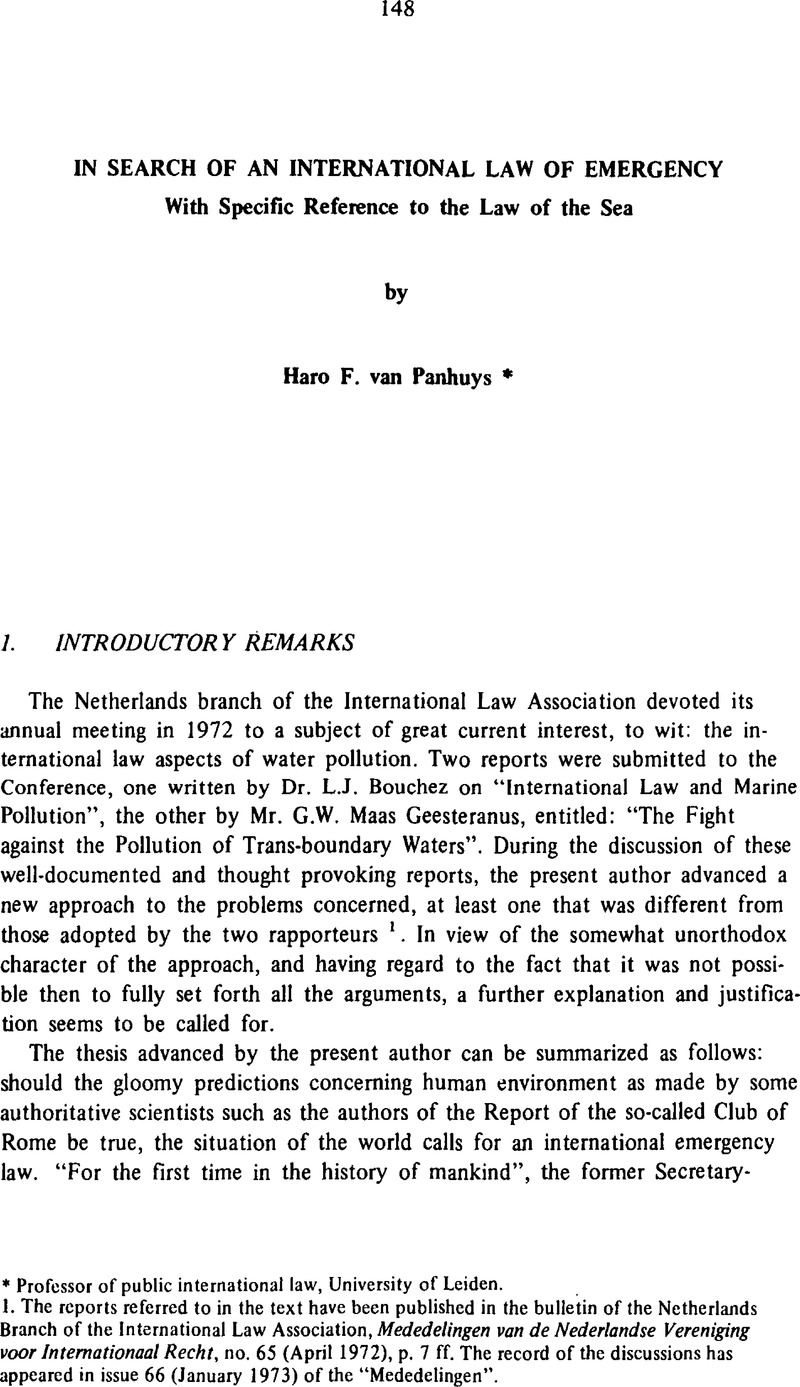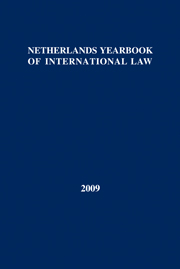No CrossRef data available.
Article contents
In search of an international law of emergency, with specific reference to the law of the sea
Published online by Cambridge University Press: 07 July 2009
Abstract

- Type
- Section B: Notes and Comments
- Information
- Copyright
- Copyright © T.M.C. Asser Press 1972
References
1. The reports referred to in the text have been published in the bulletin of the Netherlands Branch of the International Law Association, Mededelingen van de Nederlandse Vereniging voor Internationaal Recht, no. 65 (April 1972), p. 7 ff. The record of the discussions has appeared in issue 66 (January 1973) of the “Mededelingen”.
2. The quotation is taken from Kennan's, George F. article “To Prevent a World Wasteland, A Proposal” in 48 Foreign Affairs (1970), p. 401 ff., at p. 401CrossRefGoogle Scholar. The tenor of that article is that a prevention of the environmental deterioration cannot be left either to action to be taken by each individual state at the national level or to a non-committal and incidental co-operation between states at the international level.
3. Cf. on these divergent opinions Chayes, , “International Institutions for the Environment”, in Law, Institutions and the Global Environment, edited by Hargrove, , 1972, p. 1 ff., at p. 2 ff.Google Scholar
4. On the distinction between “subjective” and “objective” emergency law, cf. Van der, Pot-Donner, Handboek van het Nederlands Staatsrecht (Manual of Dutch Constitutional Law), 7th ed., 1962, p. 521 ff.Google Scholar
5. Cf. Van Dullemen, , Staatsnoodrecht en rechtsstaat (Constitutional Law of Emergency and the Rule of Law), 1946, p. 12.Google Scholar
6. In this sense, too, Van der Pot-Donner, op.cit., p. 521.
7. Cf. on this history of the law of nature, inter alia, Brierly-Waldock, , The Law of Nations, An Introduction to the International Law of Peace, 6th ed., 1963, pp. 16–25Google Scholar, in particular his reference at p. 24 to a remark of Henry Maine.
8. For the political underpinnings of this development both on the municipal and international plane, see Kaplan, and Katzenbach, , The Political Foundations of International Law, 1961, pp. 62–70.Google Scholar
9. This at least is the interpretation given to Vattel's view by the authoritive Van Vollenhoven, Dutch scholar in his book De drie treden van het Volkenrecht (The Three Stages of the Law of Nations), 1918, particularly at p. 25 ff.Google Scholar
10. Cf. François, , Handboek van het Volkenrecht, (Manual of International Law), Vol. 1, 2nd ed., 1949, p. 26 ff.Google Scholar
11. Cf. Van Eysinga, Sparsa Collecta, p. 367.
12. At p. 24 of the earlier mentioned book of Brierly-Waldock it is rightly emphasized that the appeal to reason implied in the “test of resaonableness” as applied by judges is merely to appeal to a law of nature.
13. The definition given in the text is a translation of what the Netherlands Attorney-General, Dr. Langemeyer, said in a case decided by the Netherlands Supreme Court, October 6, 1949, NJ 1950 No. 178.
14. In this connection it is of interest to note that judges, even those adhering to the scholastic doctrine of the law of nature, generally refrain from explicity referring to the law of nature in the considerations of their judgements, cf. Langemeyer, in 16 Ars Aequi (1967), p. 88.Google Scholar
15. On this matter see Van der Pot-Donner, op.cit., p. 522 ff.
16. Cf. Van Dullemen, op.cit., p. 5 and his reference there to Bluntschli.
17. Cf. Friedmann, , Théorie générale du droit, 1965, p. 104 ff.Google Scholar
18. See Tunkin, , Teoria mezhdunarodnowo prawa (Theory of International Law), 1970, p. 258Google Scholar and his reference there to Levin. Cf. also, the present author's comment in Nederlands Juristen-blad, 1970, p. 1385 ff., in particular at p. 1389.
19. Cf., e.g., Verdross, , Statisches und dynamisches Naturrecht, 1971, p. 35 ff.Google Scholar, and Kaplan and Katzenbach, op.cit., p. 17; according to Verdross (loc.cit., p. 35) Ernst Bloch is the first and only marxist writer on legal theory who has pointed to the natural law foundation of the marxist conception of law.
20. Cf. the article by the present author as referred to in note 18, and the references there mentioned.
21. I.C.J. Rep. 1966, p. 250 ff., in particular at pp. 296–300.
22. Cf. on the different interpretations given to Article 51, Brierly-Waldock, op.cit., p. 416 ff.
23. I.C.J. Rep. 1969, pp. 46–49, in particular p. 48.
24. The quoted expression is taken from Brierly-Waldock, op.cit., p. 24.
25. See, as far as the Netherlands is concerned, Article 3 of the Wet Algemene Bepalingen (the General Provisions Act) of 1829, as amended, stipulating that custom does not create law unless incorporated in legislative acts (Stb. 1829 No. 28 and 1917 No. 303); in a recent case decided by the Dutch Supreme Court a different approach was adopted which might have far-reaching results putting aside the supremacy of written law, see its decision of March 3. 1972, NJ 1972, No. 339 and 21 Ars Aequi (1972) p. 328.Google Scholar
26. On this Act see Van Panhuys, and van Emde Boas, , “Legal Aspects of Pirate Broadcasting, A Dutch Approach”, 60 AJIL (1966) p. 303 ff.CrossRefGoogle Scholar, in particular at p. 337. For an English translation of the Act see ibid., p. 340.
27. Cf., van Panhuys and van Emde Boas, loc.cit., at p. 337–338: similar problems may arise in municipal law, cf. Friedmann, , Law in a Changing Society, 2nd ed., 1972, p. 38.Google Scholar
28. Compare what Professor Röling calls the “law of nature of the atomic era”. See. e.g., his article “Oorlog en ruchtswetenschap” (War and the science of law) in: De oorlog in het licht der wetenschappen, 1st series, 1963, p. 95 ff., in particular at p. 117 ff.
29. Op.cit., p. 61.
30. 30 BFSP p. 193, as referred to by Sørensen, , Manual of Public International Law, 1961, p. 761Google Scholar; cf., also, Brierly-Waldock, op.cit., p. 405 ff.
31. Cf. about the legal rationale of the concept and its limits, inter alia, Hailbronner, K., Der Schutz der Luftgrenzen im Frieden, 1972, p. 94 ff.Google Scholar, and the sources there mentioned.
32. As to these conditions see also Brierly-Waldock, op.cit., p. 406.
33. Cf. Van Dullemen, op.cit., p. 34. Cf. also the principles of “proportionality” and “sub-sidiariness” applied in relation to “materiële wederrechtelijkheid” (as referred to above) by the Amsterdam Court of Appeal in its decisions of September 18 and 19, 1969 (NJ 1969 No. 356) in the Maagdenhuis case.
34. Cf., inter alia, an article by the present writer “Het ius ad bellum en de proportionaliteit” (Jus ad bellum and the Principle of Proportionality) in Miscellanea W.J. Ganshof van der Meersch, Studia ab discipulis amicisque in honorem egregii professoris edita, 1972. p. 237 ff.Google Scholar, with a summary in French.
35. For the text, see inter alia Van Panhuys, , Brinkhorst, and Maas, , International Organisation and Integration, 1968, p. 149.Google Scholar
36. The text of the Act has been reproduced in 9 ILM (1970) p. 543. Bouchez, loc.cit., p. 26 ff., believes that the Act is inconsistent with international law. Equally critical is Henkin, , “Arctic Anti-Pollution: Does Canada Make – or Break – International Law?”, 65 AJIL (1971), p. 131.CrossRefGoogle Scholar
37. See a summary of the Canadian note of April 16, 1970, in reply to a statement by the U.S. Government, 9 ILM (1970), p. 607. The U.S. statement appears ibid., at. p 605.
38. On this matter one should analyse, among other things, Articles 14 and 19 of the Geneva Convention on the Territorial Sea and the Contiguous Zone, of April 29, 1958, 516 UNTS p. 205.
39. On these interventions see U.N. documents A/AC 138/SC I/SR 41 (March 24, 1972), p. 9 and ibid., SR 43 (March 27, 1972), p. 5.
40. Cf., also Henkin, loc.cit., p. 134 ff.
41. See specifically Articles 1 (4), 24 and 28 of the Act.
42. Loc.cit., p. 13.
43. P.C.I.J., ser. A/10, p. 19.
44. Excluded from this hypothesis are the exceptional cases in which such extra-territorial jurisdiction may be exercised by virtue of the principle of “hot pursuit”.
45. For the text of the Declaration see U.N. document A/AC 138/80 (July 26, 1972), p. 8.
46. The text has been reproduced by Oda, S., The International Law of the Ocean Development, 1972, p. 505.Google Scholar
47. See, inter alia, NRC-Handelsblad, July 21, 22 and 23, 1971.
48. See, for instance, Dr. Bouchez in his report, at p. 13.
49. Goldie, , “Development of an International Environmental Law – An Appraisal”, in Law, Institutions and the Global Environment, 1972 (referred to in note 3 above), p. 104 ff. at p. 111.Google Scholar
50. For the text of the Act as enacted in 1971, see 10 ILM (1971), p. 584. Later, the provisions of this Act were incorporated in the consolidating Prevention of Oil Pollution Act 1971, ibid., p. 849.
51. See Article 12 of the Prevention of Oil Pollution Act 1971, particularly section 10 of that Article; the text of the Order in Council (November 22, 1971) appears in 11 ILM (1972), p. 173.
52. Text of the Convention of 1954 as amended up to 1969, in 9 ILM (1970). p. 1; for the 1971 Amendment see 11 ILM (1972), p. 267.
53. 9 ILM (1970), pp. 25 and 45.
54. Ibid., p. 359.
55. The text of this Convention has been reproduced in Shigeru, Oda, The International Law of the Ocean Development, 1972, p. 505.Google Scholar
56. Cf. Article 62 of the 1969 Vienna Convention on the Law of Treaties, 8 ILM, (1969) p. 679 ff.


